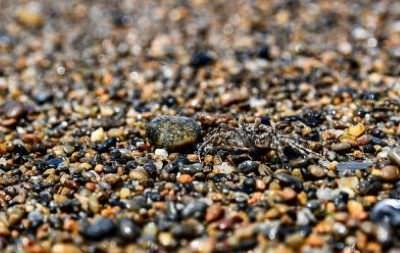6.13 掠夺
章节大纲
-
What you will learn
::你会学到什么-
What is predation
::何为掠夺 -
Dynamics of predator-
prey
::掠食动物-猎食动物的动态
What may be the most common way different species interact?
::不同物种互动的最常见方式是什么?as different as deserts and wetlands share something very important. All biomes have populations of interacting . Species interact in the same basic ways in all biomes. For example, all biomes have some species that prey on others for food .
::所有生物群落都有相互作用的群落。物种在所有生物群落中以同样的基本方式相互作用。例如,所有生物群落都有某些物种捕食其他物种的食物。Predation
::食食Predation is a relationship in which members of one species (the predator ) consume members of another species (the prey ). The lion and zebra in the Figure are classic examples of predators and prey. In addition to the lion, there is another predator in this figure. Can you spot it? The other predator is the zebra. Like the lionesses, it consumes prey species, in this case, species of grass. However, unlike the lionesses, the zebra does not kill its prey. Predator-prey relationships such as these account for most energy transfers in and food webs .
::捕食是一种关系,一种物种(捕食者)的成员消费另一种物种(猎物)的成员。图中的狮子和斑马是捕食者和猎物的典型例子。除了狮子之外,还有另一个捕食者。你可以看到吗?另一个捕食者是斑马。它像狮子一样,消费猎食物种,这里是草种。然而,与狮子女不同,斑马不杀死猎物。捕食者与猎食者之间的关系,如捕食者之间的关系,是大部分能量在食物网中转移的原因。Predators and Their Prey. The lion feeds on the carcass of a zebra. Predation and Population
::食食和人口A predator-prey relationship tends to keep the populations of both species in balance . This is shown by the graph in the Figure below. As the prey population increases, there is more food for predators. So, after a slight lag, the predator population increases as well. As the number of predators increases, more prey are captured. As a result, the prey population starts to decrease. What happens to the predator population then?
::捕食者与猎食者之间的关系往往使这两种物种的数量保持平衡。下图中的图表显示了这一点。随着猎食者数量的增长,捕食者的食物数量会增加。因此,在稍稍落后之后,捕食者的数量也会增加。随着捕食者数量的增加,捕食者的数量也会增加。结果,猎食者的数量开始减少。然后,掠食者的数量会怎样呢?Predator-Prey Population Dynamics. As the prey population increases, why does the predator population also increase? In the predator-prey example, one factor limits the growth of the other factor. As the prey population decreases, the predator population begins to decrease as well. The prey population is a limiting factor . A limiting factor limits the growth or of an organism , population, or process.
::在食肉动物-食肉动物的例子中,一个因素限制了其他因素的增长,随着猎物种群的减少,捕食动物种群也开始减少,猎物种群是一个限制因素,一个限制因素限制了有机体、人口或过程的增长。Keystone Species
::关键物种Some predator species are known as keystone species . A keystone species is one that plays an especially important role in its community. Major changes in the numbers of a keystone species affect the populations of many other species in the community. For example, some sea star species are keystone species in coral reef communities. The sea stars prey on mussels and sea urchins, which have no other natural predators. If sea stars were removed from a coral reef community, mussel and sea urchin populations would have explosive growth. This, in turn, would drive out most other species. In the end, the coral reef community would be destroyed.
::一些掠食性物种被称为关键物种,一种关键物种是在其社区中发挥着特别重要的作用。一个关键物种的数量发生了重大变化,影响到社区中许多其他物种的数量。例如,一些海星物种是珊瑚礁社区中的关键物种。海星捕食的是贝类和海胆,没有其他自然捕食者。如果海洋恒星从珊瑚礁社区中消失,则贝类和海胆种群将具有爆炸性增长。这反过来将驱走大多数其他物种。最终,珊瑚礁种群将遭到破坏。Adaptations to Predation
::对掠夺的适应Both predators and prey have adaptations to predation that evolve through . Predator adaptations help them capture prey. Prey adaptations help them avoid predators. A common adaptation in both predator and prey is camouflage . Several examples are shown in the Figure . Camouflage in prey helps them hide from predators. Camouflage in predators helps them sneak up on prey.
::食肉动物和猎食动物都有适应性来适应通过 . 食肉动物的适应性能有助于捕食猎物。 食肉动物的适应性能有助于它们避免食肉动物。 食肉动物和猎食动物的共同适应性是伪装。 图中列举了几个例子。 猎物中的黑旗有助于它们躲避食肉动物。 食肉动物的岩旗能帮助它们潜入猎物。Camouflage in Predator and Prey Species. Can you see the crab in the photo on the left? It is camouflaged with the sand. The praying mantis in the middle photo looks just like the dead leaves in the background. Can you tell where one zebra ends and another one begins? This may confuse a predator and give the zebras a chance to run away. Science Friday : Can Underwater Parks Protect Coral?
::科学星期五:水下公园能保护珊瑚吗?Coral communities are incredibly important for life. In this video by Science Friday , Marine scientists John Bruno and Elizabeth Selig describe the effects of local Marine Protection Areas on preserving coral.
::珊瑚群对生命至关重要。 在科学星期五的这段视频中,海洋科学家约翰·布鲁诺和伊丽莎白·塞利格描述了当地海洋保护区对保护珊瑚的影响。
Summary
::摘要-
Predation is a relationship in which members of one species (the predator) consume members of another species (the prey).
::掠夺是一种关系,一种物种的成员(捕食者)消费另一种物种的成员(猎物)。 -
A predator-prey relationship keeps the populations of both species in balance.
::掠食动物与猎食动物之间的关系使这两种物种的种群保持平衡。
Review
::回顾-
Describe the relationship between a predator population and the population of its prey.
::描述捕食者人口与其猎物人口之间的关系。 -
What is a keystone species? Give an example.
::什么是关键物种?举个例子。 -
What is a limiting factor?
::什么是限制因素? -
What is the role of camouflage in prey and predator?
::伪装在猎物和掠食者中的作用是什么?
-
What is predation




